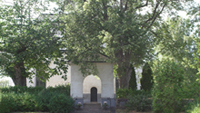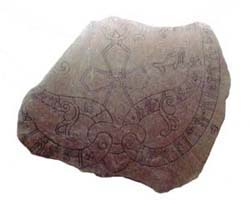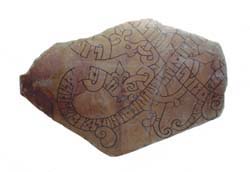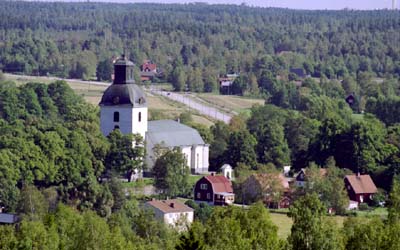
Ovansjö church
A church made of stone was built in Ovansjö in the 13th century. Some radical changes and refurbishment were undertaken in the 1760's. It was at that time that the church was given is present look, but some parts still remain from the original frame.
Ovansjö church is a church known for its sculptures. Maintained sculptures from the 15th century can still be seen here.
You can read more about the history of Ovansjö church below. For information about the church services and activities please contact the parish, Ovansjö församling.
View a slideshow of Ovansjö church by Mikael Lundh and Sonja Karlsson Lundh. Music: "Jämtländsk kärleksvisa" played by organist Jan-Olov Berglund.
|
Ovansjö church building history
As early as the 13th century there has been a church in Ovansjö. In its first form the church had a rectangular shape and no belfry. The rounded portal originating from the middle of the 13th century is still preserved. During the 13th and 14th century a sacristy was added to the north and a porch for keeping weapons was built to the south. In the southern part was also the low entrance. During the later part of the 15th century the wooden roof was replaced with bricks. The door was provided with plating and a Gothic door ring. It has been said that the county's middle age seal was kept in Ovansjö church in Kungsgården behind an iron door with nine locks. During the 17th century big changes were made to the church. Braces were put in to steady the walls in 1645 and the windows were enlarged in 1665. The interior was painted white. The present portal of red sandstone was built in 1685 following a donation by Isac Mackey and Anna Leufstadia. Two years later new benches and a new cross shape with pyramids by Jöran Snickare (which was changed in 1742) was installed. In 1688 the old bell frame was replaced by a new. During the 18th century more room was needed and a new stand for women was built in 1713. There was still not enough room and yet another refurbishment was planned. The master builder of Gävle town, Daniel Lundkvist, was assigned the task of planning the new look of the church which he started in August 1759. It was between 1760-63 that the church got its present appearance. Between 80-150 men per day were working on building the new church. The church was broadened towards the north. The long part was extended towards the west where also a belfry was built. The sacristy was built to the east of the sanctuary. The eastern wall of the sacristy has a portal with iron mountings on its door. This belonged most probably to one of the portals of the middle aged church. The porch was demolished and the portals moved to the new entrances towards the south and west.
Work on the belfry has been performed during spring and summer 2004. The work included among others replacement of decay damaged timber, sheet metal work and replacement of parts of the roof, painting and polishing of lantern, clock face, spire and adornment on the belfry.
The churchyard The churchyard is surrounded by a wall, which was originally covered by a roof made of shavings. The wall has two portal gates from 1763 and 1788. A storehouse made of sandstone and bricks were built during the 18th century.
Interior and paintings in Ovansjö church Rune stones - During the Viking period rune stones were erected as monuments, or to mark borders. The rune stones were erected along roads, road crossings, bridges, graveyards and where local councils were held. Runes were used in Northern Europe from the time of Christ until well into the 19th century. Two rune stones, which are believed to have been carved in the 11th or 12th century are kept in Ovansjö church. The rune stones were found at the Vicarage, Grimstad.
The Altar - The present retable in three sections is a typical baroque style was acquired in 1690. The present altar rails were added at the refurbishment in 1963. The oil paintings representing the Eucharist, Crucifixion and Funeral is made by Johan Wulf. The framework is richly sculptured by Jochum Lütkenschwager. A clock face was inserted in one of the paintings in 1742. Among the carved figures Petrus with his key and Paulus with his sword can be seen. The retable shows a victorious Christ standing on the dragon with the cross banner in his left hand. The Pulpit - The pulpit was made 1662 by Ewert Friis. He originated from Bredstedt in northern Germany and one can clearly observe the continental influence in his rich carvings in all these artworks. Christ and the six apostles are pictured on the pulpit. The roof shows Christ with the cross banner and around the edges of the roof are angels with Christ's instrument of torture and on the top Christ as the world's saviour. The decorations on the stairs with the robust columns and clinging vine were added in 1743 by sculptor Petter Blom. The baptismal font - The baptismal font, made of limestone from the Swedish island Gotland, is a work from the later parts of the 13th century. A wooden stand for christening was made by Petter Blom 1742 because the latter was looked upon as unfashionable. The middle aged font was however later restored. A fint of the same sort can be found in Svärdsjö church in Dalarna. Sculptures - From the first era of the church, during the middle of the 13th century, there remains an enthroned Madonna with the Holy Child on her knees. This sculpture can be found on the northern wall of the sanctuary. On the same wall towards the west are two fragments from a triptych, which probably originates from the middle of the 15th century. One of them is a blessed Christ sitting on a throne and the other is a representation of the death of Mary. In the triumphal arch hangs a crucifix from the late middle ages. The saint Mary sculpture on the south wall originates from late 15th century or early 16th century. The Madonna is represented as an apocalyptic woman with the crescent moon under her feet. Another sculpture represents the holy Birgitta and her open book. Two pyramids remained from the old cross of 1667. The church organ and the bells - The facing of the church organ is made after drawings by E A Hedin. The organ is from 1897, but has since been rebuilt. The large bell is said to have been cast in 1670 by Johan Meijer. The small bell is from 1806 and the middle bell from 1901. Chandeliers - The oldest of the chandeliers is one made of ore and has 16 candle pipes. It was bought in 1662 from the iron works in Skultuna. Chandeliers, candlesticks and candle arms have been donated over the years to the church by among others, the local squires in the 17th and 18th century. The number tables- One of the two number tables with gilded wood and painted inscriptions was donated to the church by Anna Mackey in 1744 and the other by Justina Chaterina Reftalia in 1777. The holy Birgitta When our medieval churches were opened big celebrations were held. The new church should be sanctified and it was common that the church's saint was displayed in church. We know that the parish in Ovansjö used to celebrate "the Britta mass" on 7th October each year until as late as 1920. It is therefore believed that St. Birgitta was the old church's saint.
|
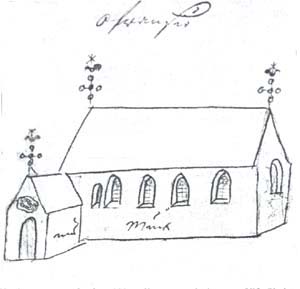
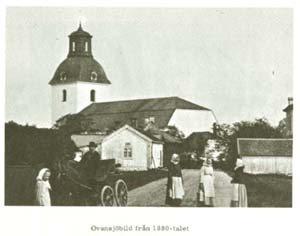 Ten
years later the vaults had to be repaired because of cracks and
another refurbishment was made by the city architect in Gävle
of that time, E A Hedin. A vault was bricked above the sanctuary.
The interior walls were covered with brown oil paint and the vault
provided with stencils in blue and brown. The next refurbishment
was made 1963-64 after sketches by the architect J Thomé who had previously built the church in the village of Storvik. The
vault was strengthened and the interior paint from the 19th century
was exchanged with light grout on the vault and walls. During this
work it was discovered that, during the refurbishment in the beginning
of 1760, stones with fragments from the middle aged mural paintings
had been used. Unfortunately those paintings were blasted away before
being documented. At the restoration the porch was equipped with
new inner doors made of glass and iron. Two
Ten
years later the vaults had to be repaired because of cracks and
another refurbishment was made by the city architect in Gävle
of that time, E A Hedin. A vault was bricked above the sanctuary.
The interior walls were covered with brown oil paint and the vault
provided with stencils in blue and brown. The next refurbishment
was made 1963-64 after sketches by the architect J Thomé who had previously built the church in the village of Storvik. The
vault was strengthened and the interior paint from the 19th century
was exchanged with light grout on the vault and walls. During this
work it was discovered that, during the refurbishment in the beginning
of 1760, stones with fragments from the middle aged mural paintings
had been used. Unfortunately those paintings were blasted away before
being documented. At the restoration the porch was equipped with
new inner doors made of glass and iron. Two 